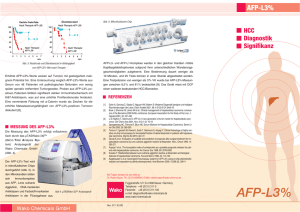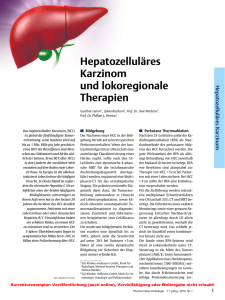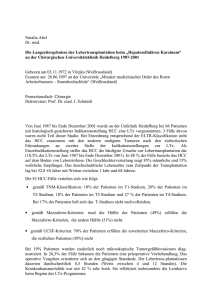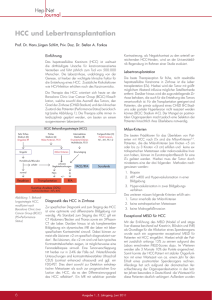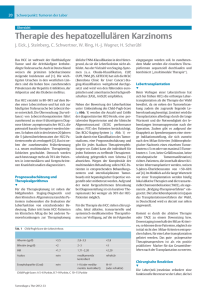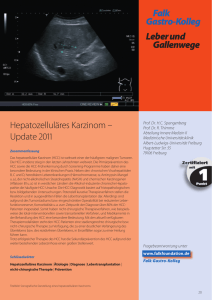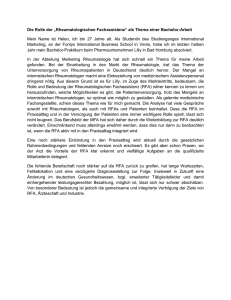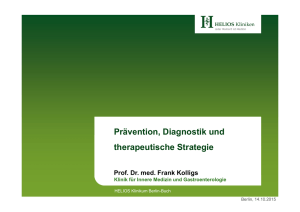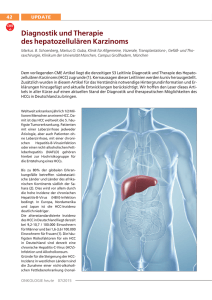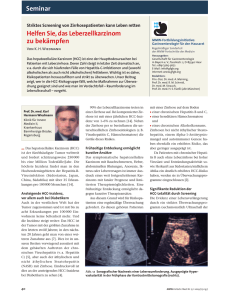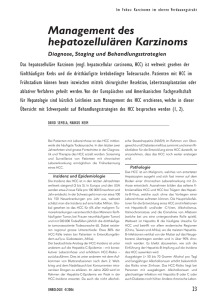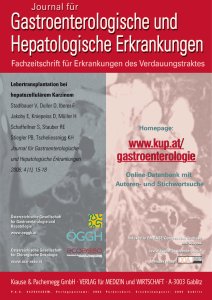Reto Bale: HCC – intermediäre Stadien
Werbung
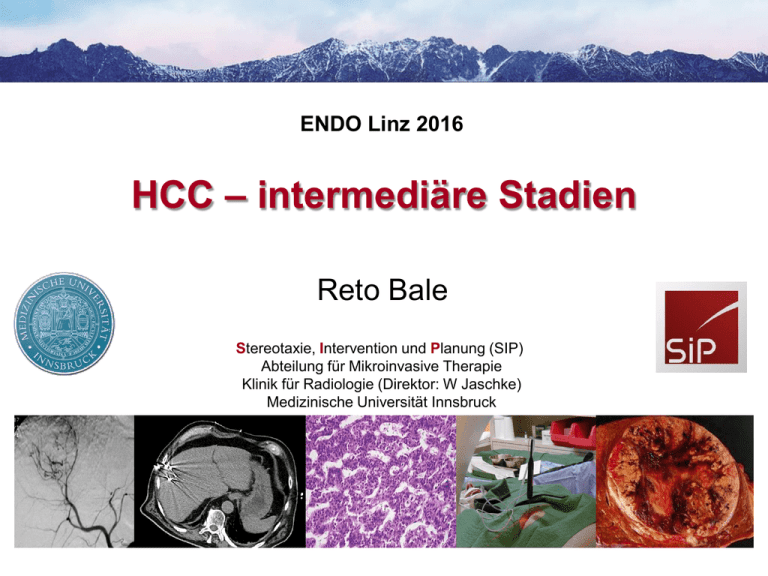
ENDO Linz 2016 HCC – intermediäre Stadien Reto Bale Stereotaxie, Intervention und Planung (SIP) Abteilung für Mikroinvasive Therapie Klinik für Radiologie (Direktor: W Jaschke) Medizinische Universität Innsbruck BCLC staging and treatment strategy Multinodulär (> 3 HCCs) Kein Pfortadereinbruch Keine extrahepat. M. Forner, A. et al. (2014) Treatment of intermediate-stage hepatocellular carcinoma Nat. Rev. Clin. Oncol. doi:10.1038/nrclinonc.2014.122 BCLC staging and treatment strategy Multinodulär (> 3 HCCs) Kein Pfortadereinbruch Keine extrahepat. M. Reprinted from The Lancet, 379, Forner, A., Llovet, J. M. & Bruix, J. Hepatocellular carcinoma, 1245–1255 © 2012, with permission from Elsevier Forner, A. et al. (2014) Treatment of intermediate-stage hepatocellular carcinoma Nat. Rev. Clin. Oncol. doi:10.1038/nrclinonc.2014.122 Forner, A. et al. (2014) Treatment of intermediate-stage hepatocellular carcinoma Nat. Rev. Clin. Oncol. doi:10.1038/nrclinonc.2014.122 TACE Superselektive, flusskontrollierte Injektion einer LipiodolEpirubicin Emulsion bis zur Stase Evtl. PVA Partikel falls notwendig Multiple Embolisationssitzungen 4-6 Wochenintervalle; 1-3 Sitzungen Endpunkte: Devaskularisation der Tumore, komplette homogene Lipiodolanreicherung CT als Qualitätskontrolle TACE vs. Best supportive care 1 Jahr 2 Jahre TACE Kontrolle 82% 63% 63% 27% 1 Jahr 2 Jahre 3 Jahre TACE Kontrolle 57% 31% 26% 32% 11% 3% BCLC staging and treatment strategy Multinodulär (> 3 HCCs) Kein Pfortadereinbruch Keine extrahepat. M. Reprinted from The Lancet, 379, Forner, A., Llovet, J. M. & Bruix, J. Hepatocellular carcinoma, 1245–1255 © 2012, with permission from Elsevier Forner, A. et al. (2014) Treatment of intermediate-stage hepatocellular carcinoma Nat. Rev. Clin. Oncol. doi:10.1038/nrclinonc.2014.122 Forner, A. et al. (2014) Treatment of intermediate-stage hepatocellular carcinoma Nat. Rev. Clin. Oncol. doi:10.1038/nrclinonc.2014.122 Radiofrequenzablation LOKAL KURATIV! 100° C 90° C 80° C 70° C 60° C 50° C 40° C Radiofrequenzablation LOKAL KURATIV! HCC < or = 3 cm Lokale Kontrollrate: PEI vs. RFA 80% vs. 90% Livraghi et al. Radiology (1999) Überleben nach RFA von early-stage HCCs Prospektive randomisierte Studie bei 102 Patienten 1- und 2-J Lokalrezidivfreie Überlebensraten RFA(98% and 96%) PEI (83% and 62%) Lencioni et al. (2003) Intention-to-treat Studie 187 Patienten mit early stage HCC 5-Jahresüberlebensraten: Gesamt Child A und solitäre HCCs 48%. 61%. Lencioni et al.(2005) BCLC staging and treatment strategy Multinodulär (> 3 HCCs) Kein Pfortadereinbruch Keine extrahepat. M. Forner, A. et al. (2014) Treatment of intermediate-stage hepatocellular carcinoma Nat. Rev. Clin. Oncol. doi:10.1038/nrclinonc.2014.122 Radiofrequenzablation LOKAL KURATIV! HCC < or = 3 cm Lokale Kontrollrate: PEI vs. RFA 80% vs. 90% Livraghi et al. Radiology (1999) ABER... HCC (3 -5.0 cm) Lokale Kontrollrate: RFA vs. TACE plus RFA 30% vs. 60% Kim et al. Ann Surg Oncol ( 2011) Radiofrequenzablation LOKAL KURATIV! HCC < or = 3 cm Lokale Kontrollrate: PEI vs. RFA 80% vs. 90% Livraghi et al. Radiology (1999) ABER... HCC (3 -5.0 cm) Lokale Kontrollrate: RFA vs. TACE plus RFA 30% vs. 60% Kim et al. Ann Surg Oncol ( 2011) Ziel Komplette Tumorentfernung Ziel Komplette Tumorentfernung Ziel Komplette Tumorentfernung Stereotaxie Bildgebung CT-Kontrolle Plannung Ablation Zielen Bildfusion Nadelplatzierung (3-28, MW 8) 100% 95.9% 100% 87.5% < 3 cm 3-5 cm > 5 cm 50% 0% Bale RJ, Freund M, Bodner G, Kovacs P, Jaschke W (2002) Precise Computer- assisted Liver Tumor Puncture for Biopsy and Thermal Ablation 88th Scientific Assembly and Annual Meeting of the Radiological-Society-of-North-America Radiology 225(S): 242-242 Purpose: Our purpose was the development and evaluation of a novel patient immobilization device and a novel aiming device for frameless stereotactic interventional procedures in the liver in 20 patients. Material and Methods: After oral intubation the patient is placed upon a vacuum mattress on the CT table, wrapped up with cushions and covered with a plastic sheath. When the BodyFix (Medical Intelligence, Schwabmünchen, Germany) vacuum pump is turned on the cushions hardens and the patient is sucked against the CT couch resulting in rigid patient immobilization. A 3mm contrast –enhanced helical CT scan is performed in exspiration. The pathway to the target point is determined on the 3D – CT dataset on the StealthStation navigation system (Medtronic Inc. Boulder, USA). After sterile draping the Vertek aiming device allows for precise alignment of the probe of the navigation system with the preplanned trajectory. In exspiration the needle is advanced through the targeting device to the target. The novel technique was used for liver tumor biopsy in 8 patients and thermal ablation in 12 patients. The accuracy of needle placement was determined on a CT scan in exspiration with the needle in place. Results: Image-fusion revealed a lateral needle displacement within 1-5 mms in all patients (mean error 3.2 mm). The whole procedure including immobilization, general anaesthesia, adjustment of the targeting device and tissue sampling took about 1-2 hours per patient. Conclusion: The novel method allows for safe puncture of small lesions in the liver with high accuracy. The same method can be used for virtually every lesion in the whole body for various procedures including biopsy, LITT and thermal ablation. Bale RJ, Freund M, Bodner G, Kovacs P, Jaschke W (2002) Precise Computer- assisted Liver Tumor Puncture for Biopsy and Thermal Ablation 88th Scientific Assembly and Annual Meeting of the Radiological-Society-of-North-America Radiology 225(S): 242-242 > 600 Patienten mit > 1200 Lebertumoren mit Stereotaktischer RFA behandelt Thermoablation jenseits der Leitlinien T.F. 71 J. HCC Segment VIII/V 8 cm + ein Satellitenherd mit 1,5 cm 20 Sondenpositionen Nach 2.5 J SRFA Innsbruck 2005-2015 266 Patienten mit 605 HCCs Very early Stage (0): Early Stage (A): Intermediate Stage (B): Advanced Stage (C): 13.5% (36/266) 36.5.6% (97/266) 43.2% (115/266) 1.5% (4/266) Mediane Tumorgröße: Tumoranzahl: 2.8 cm (1-19 cm) 1-12 > 44.7 % außerhalb der BCLC Therapieempfehlungen Lokalrezidive: 50/605 (8.3%) Mortality: 2.7% Complications: 9.1% HCC OS Group Median (months) 1-year 3-year 5-year Overall 60 90% 66% 52% n = 266 Intermediäre HCCs inkl. LTX n = 115 (LTX: n=17) Intermediäre HCCs exkl. LT n = 98 (LTX: n=0) BCLC staging and treatment strategy SRFA (+/- LT) OS Exkl.LT: 44 Mo Inkl. LT: 56 Mo Reprinted from The Lancet, 379, Forner, A., Llovet, J. M. & Bruix, J. Hepatocellular carcinoma, 1245–1255 © 2012, with permission from Elsevier Forner, A. et al. (2014) Treatment of intermediate-stage hepatocellular carcinoma Nat. Rev. Clin. Oncol. doi:10.1038/nrclinonc.2014.122 Forner, A. et al. (2014) Treatment of intermediate-stage hepatocellular carcinoma Nat. Rev. Clin. Oncol. doi:10.1038/nrclinonc.2014.122 174 HCC Patienten mit LTX 2002-2013, 48 (28%) BCLC B 5-yr OS CR 87% vs. PD 62% (P = 0.02). Tumorstadium (BCLC 0- A- B) kein signifikanter Einfluss auf OS! HCC Rezidiv nach LTX Bei CR kein Unterschied der HCC Rezidivrate nach LTX zwischen 0-A-B. Bei CR nach neoadjuvanter Therapie ist Stadium kein Risikofaktor! CR 72% 21.4% SRFA (n=39): TACE/TAME (n=84): (p<0.001) RFA: mehr Patienten mit BCLC 0 oder A SD 20.5% 45.3% PD 7.5% 33.3% 174 HCC Patienten mit LTX 2002-2013, 48 (28%) BCLC B 5-yr OS CR 87% vs. PD 62% (P = 0.02). Tumorstadium (BCLC 0- A- B) kein signifikanter Einfluss auf OS! HCC Rezidiv nach LTX Bei CR kein Unterschied der HCC Rezidivrate nach LTX zwischen 0-A-B. Bei CR nach neoadjuvanter Therapie ist Stadium kein Risikofaktor! HCC Rezidive nach LTX bei Patienten ohne Progression nach Bridging: Grading Gefäßeinbruch Take Home Points Bei Patienten mit intermediärem HCC macht ein aggressiver/kurativer Ansatz Sinn! ERGO: 1. Wahl: Lokal kurative (S)RFA +/- LTX 2. Wahl: TACE +/- LTX ... oder Kombination LTX nach CR (ev. PR) sinnvoll (DOWNSTAGING) Thermoablation jenseits der Leitlinien SRFA OS 2004-2010 17 Patients 52 ICCs Update WKM 2013 1year 3year 5 year Median Survival RES 91% 71% 68% 60 months 18 – 30 months Mainly unresectable ICCs SRFA Madariaga et al 1999 Endo et al 2008 A.F. 60 J., männlich Inoperables ICC (18 cm) mit Infiltration der V. cava 10 Monate später 4 yrs. later STEREOTAXY
